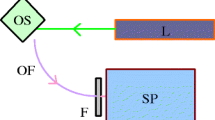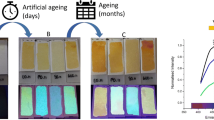Abstract
Color changes of virgin-olive-oil samples contained in cells with different thicknesses were analyzed. Ten different commercial virgin olive oils were measured at different sample thicknesses by two methods: conventional spectrophotometry (5.0, 10.0, and 50.0 mm path length cells), and spectroradiometry (cylindrical cells with 8.0, 11.2, 15.6, 19.6, 23.2, 27.2, 36.8 and 46.4 mm internal diameters) with samples placed on the floor of a commercial cabinet using a standard daylight source. The illumination in these two methods was different, resulting in notable color differences in the samples. Color variations of virgin olive oils depending on thickness do not follow the same trend for all samples. Neither the Bouguer-Lambert-Beer law nor the Kubelka-Munk theory provided successful color predictions in the whole range of thicknesses considered here. We can conclude that for precise and reproducible color measurements of virgin-olive-oil color, it is necessary to fix both the thickness of the sample and the illumination geometry. To achieve an easier communication between industries and/or consumers, we propose that virgin-olive-oil color be measured using a spectrophotometer with 5.0-mm path length cells, for three reasons: conventional olive-oil laboratories have spectrophotometers more often than spectroradiometers; with virgin olive oils the cleaning of 5.0 mm cells is easier than for 1.0 mm cells and it does not consume a large amount of oil; spectrophotometric signals for 5.0-mm path length cells allow reliable measurements of even the darkest virgin-olive-oil samples.











Similar content being viewed by others
References
Alba J, Izquierdo JR, Gutiérrez F (1997) Aceite de oliva virgen. Análisis sensorial. Madrid. Agrícola Española, SA
Standard COI/T.20/Doc. nº5 (1987) Glass for olive oil tasting
Moyano MJ, Melgosa M, Alba J, Hita E, Heredia FJ (1999) Reliability of the bromthymol blue method for color in virgin olive oils. J Am Oil Chem Soc 76:687–692
Melgosa M, Pérez MM, Hita E, Heredia FJ, Alba J, Moyano MJ (2000) Precision and accuracy in the color specification of virgin olive oils from the bromthymol blue method. J Am Oil Chem Soc 77:1093–1099
Martínez JA, Melgosa M, Pérez MM, Hita E, Negueruela AI (2001) Note. Visual and instrumental color evaluation in red wines. Food Sci Tech Int 7:439–444
Huertas R, Yebra A, Pérez MM, Melgosa M, Negueruela AI (2003) Color variability for a wine sample poured into a standard glass wine sampler. Color Res Appl 28:473–479
CIE Publication 15:2004 (2004) Colorimetry (Technical Report), International Commission on Illumination (CIE), CIE Central Bureau, Vienna
Moyano MJ (2002) Estudio del color de aceites de oliva vírgenes de Andalucía. PhD dissertation. Facultad de Farmacia (Universidad de Sevilla), Instituto de la Grasa (CSIC), Sevilla, Spain
Melgosa M, Pérez MM, Hita E, Heredia FJ, Alba J, Moyano MJ (2001) Reproducibility of the bromthymol blue standards used for color specification of virgin olive oils. J Am Oil Chem Soc 78:265–270
Sánchez-Marañón M, Delgado G, Delgado R, Pérez MM, Melgosa M (1995) Spectroradiometric and visual color measurements of disturbed and undisturbed soil samples. Soil Sci 160:291–303
Berns RS (2000) Billmeyer and Saltzman’s principles of color technology, 3rd edn. Wiley, pp 157–167
Roa R, Huertas R, López-Álvarez MA, Gómez-Robledo L, Melgosa M (2008) A comparison between illuminants and light-source simulators. Opt Pur Apl 41:291–300
Hard A, Sivik L, Tonnquist G (1996) NCS, natural color system—from concepts to research and applications. Part I. Color Res Appl 21:180–205; Part II. Color Res Appl 21:206–220
Judd DB, Wyszecki G (1972) Color in business, science and industry. Wiley, pp 420–438
CIE Publication 116-1995 (1995) Industrial colour-difference evaluation. CIE Central Bureau, Vienna
CIE Publication 142-2001 (2001) Improvement to industrial colour-difference evaluation. CIE Central Bureau, Vienna
Melgosa M (2000) Testing CIELAB-based color-difference formulas. Color Res Appl 25:49–55
Lomas AM, Negueruela AI, Echavarri JF (1994) Determination of the color of Rioja red wine by trans-reflectance. Opt Pur Apl 27:70–77
Hutchings JB (1999) Food color and appearance, 2nd edn. Aspen Publishers, pp 198–203
Acknowledgments
Research Project P06-AGR-01744, Consejería de Innovación, Ciencia y Empresa, Junta de Andalucía (Spain), with FEDER support. Anonymous referees’ comments are also acknowledged.
Author information
Authors and Affiliations
Corresponding author
About this article
Cite this article
Gómez-Robledo, L., Melgosa, M., Huertas, R. et al. Virgin-Olive-Oil Color in Relation to Sample Thickness and the Measurement Method. J Am Oil Chem Soc 85, 1063–1071 (2008). https://doi.org/10.1007/s11746-008-1291-1
Received:
Revised:
Accepted:
Published:
Issue Date:
DOI: https://doi.org/10.1007/s11746-008-1291-1




